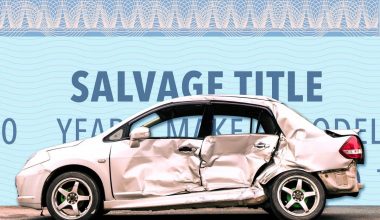In the event of a car accident, regardless of who was at fault, you must submit a claim for damages to your own insurance company. Depending on the state you live in, no-fault insurance may cover a variety of expenses, including medical costs, lost wages, child care, and more. It may be crucial for drivers to understand whether their state has fault-based or no-fault laws. It not only affects how you file claims, but it might also have an impact on the kind of auto insurance you require and the price of your insurance premium. This article explains all you need to know about no-fault insurance
No-Fault Insurance
In a no-fault state, your insurance company will pay your medical costs and lost wages up to the coverage limit regardless of who was at fault for the covered accident. In states with no-fault insurance, personal injury protection (PIP) coverage is required in addition to standard liability insurance.
PIP insurance does not pay for damages to your car, the medical costs of another driver, or medical bills that exceed the maximum allowed by your policy. No-fault insurance, also known as PIP, offers coverage for injuries you sustain in a car accident regardless of who was at fault, up to the limit of PIP coverage you have, and pays out immediately, lowering the possibility that one party will file a lawsuit against the other.
How Does No-Fault Coverage Work?
Consider a scenario in which you are in an accident that leaves you with two broken arms and you reside in a no-fault state. No matter who caused the collision, you must provide the hospital with the details of your auto insurance policy when you visit the emergency room to have the arms looked at. If you choose to pay for the medical care out-of-pocket, your insurer should send you a check for the amount you spent (up to the limit of your personal injury protection coverage). Alternatively, if the hospital bills your insurance company directly, they should reimburse you for the costs of the medical care.
No-Fault Insurance States
A “no-fault state” is one that has an insurance system that mandates that anyone hurt in a car accident must first seek compensation from their insurance, regardless of who was at fault.
In 12 states, no-fault auto insurance is a legal requirement; in a few others, it is an add-on that you can purchase as an extra. Some states allow you to completely forego no-fault insurance. A different name for this insurance is personal injury protection or PIP.
Which States Have No-Fault Insurance Laws?
The following states require drivers to have this insurance policy:
- Delaware
- Florida
- Hawaii
- Kansas
- Kentucky
- Massachusetts
- Michigan
- Minnesota
- Pennsylvania
- New York
- North Dakota
- Utah
Pure” or “True” No-Fault States
Pure (or “true”) no-fault insurance refers to contracts that limit drivers’ legal recourse while the driver’s insurance pays first-party benefits to them and their passengers. First-party benefits denote the fact that the driver’s insurance company will cover all of their expenses, including medical bills, regardless of who is at fault. Pure no-fault laws are present in the following states:
- Florida
- Hawaii
- Kansas
- Kentucky
- Massachusetts
- Michigan
- Minnesota
- New Jersey
- New York
- North Dakota
- Pennsylvania
- Puerto Rico
- Utah
There are various minimum standards in each of the states that mandate no-fault insurance. For instance, policyholders can choose from a variety of insurance options in Michigan. Drivers can choose from the following options when determining their no-fault insurance coverage limit: They are qualified for up to $500,000 in coverage, or $250,000 in coverage.
Additionally, if they are Medicaid enrollees and a member of their household has insurance that will cover injuries sustained in auto accidents, they have the choice to receive up to $50,000 in coverage.
In addition, policyholders have the choice to decline PIP medical coverage if they have Medicare and another family member is covered by health or auto insurance for injuries sustained in auto accidents.
In Florida, no-fault insurance only pays up to a maximum of $10,000 for 80% of your accident-related medical costs. While no-fault insurance in New York pays up to $50,000 for medical expenses for you and your passengers, it only reimburses 80% of lost wages.
Choice No-Fault States
States that give residents the option between pure no-fault and a conventional auto insurance plan that doesn’t limit their ability to sue are referred to as choice no-fault states. Here, policyholders have the option to choose a pure no-fault insurance policy or a more traditional auto insurance policy that gives them the right to sue. Such states include New Jersey, Kentucky, and Pennsylvania
Add-on No-Fault States
Add-on no-fault policies are a mix. Drivers have the same legal rights as with a standard auto insurance policy, but they also have the option of purchasing first-party coverage, which means that their own insurance company will cover their medical bills and other costs. Lawsuits in this area are not subject to any limitations. Policyholders can choose to sue.
What Does a No-Fault Insurance Cover
Car-related injuries are covered by no-fault insurance. This insurance policy will pay for any medical costs incurred as a result of a car accident if you are hurt. No-fault insurance may also include the following benefits, depending on the state.
It also covers lost wages if your injury prevents you from working, substitute services like child care, or house cleaning, funeral costs in the event of a fatal injury, Survivor’s loss, or a modest death benefit, if the accident results in your passing and you have dependents who will live on after you.
What Won’t a No-Fault Policy Cover?
In a no-fault state, PIP will probably not pay for the following costs:
#1. Injuries to the Passengers or Other Drivers of the Other Vehicle
Most of the time, these should be initially covered by the other driver’s PIP insurance. If the insurance on your policy does pay for these expenses, it would come from your bodily injury liability coverage.
#2. Injuries to Pedestrians
If you are hit by a car while out walking, your PIP will probably cover you. However, if you are driving and hit a pedestrian or cyclist, their insurance should typically pay for it. You cannot include pedestrians in your no-fault policy.
#3. Medical Expenses That Exceed Your Insurance’s Cap
More coverage than what your policy allows is not possible. However, if the other driver was at fault for the collision, you might be able to sue them for damages that exceed your insurance coverage in some states.
What Are the Benefits of No-Fault Insurance?
The speed with which claims are settled is one of the no-fault policy main advantages. It expedites the process to pay for any auto or medical bills because there is no longer any back and forth between insurance companies trying to determine who is at fault.
This method saves money in addition to saving time. By dealing with your own insurance company directly, you can avoid the high costs of bringing an at-fault driver to justice.
No-Fault Insurance Claim
If you have no-fault auto insurance and are in a car accident, you must first decide whether to make any claims at all. If you or a passenger in your car suffered an injury, you might need to file a claim.
You would get in touch with your insurance provider to submit any injury-related claims since this is no-fault insurance. You would have to provide information about the incident, the severity of your injuries, and proof of any out-of-pocket expenses for medical care or lost wages.
The insurance provider would then handle your claim and reimburse you for your expenses up to the coverage limits specified in your policy. A no-fault policy has the benefit of allowing claims to be paid out much more quickly because there is no need to establish fault.
What Is No-Fault Insurance in the USA?
Regardless of who was at fault for the collision, a no-fault policy is intended to pay for your medical bills and/or lost wages if you are in one. No-fault auto insurance may be required by some states, but it may also be optional in others.
What Are the Pros and Cons of No-Fault Insurance?
No-fault insurance has the advantage of ensuring prompt claim settlements following accidents and lowering the number of lawsuits filed for relatively minor injuries. The disadvantages include higher auto insurance rates and a more challenging process for drivers seeking pain and suffering damages. Additionally, it exempts careless drivers from financial responsibility for their deeds.
How Does Insurance Work When It’s Not Your Fault?
Making a no-fault car insurance claim eliminates the concern that the insurance provider will reject your claim due to a disagreement over who was at fault for the collision. You are not required to carry the burden of demonstrating to an insurance adjuster that you were not at fault for the collision.
What Does No-Fault Insurance Mean in Canada?
Although you will only be dealing with your insurer if you have no-fault auto insurance, this does not mean you are not at fault. No-fault insurance, as defined in formal terms, is coverage provided by your insurer, not another party’s, for any reimbursement resulting from a loss caused by an insured risk.
What Is the Opposite of No-Fault Insurance?
At-fault insurance is the antithesis of no-fault coverage. Whether the victim has a legal right to sue determines whether an insurance policy is at-fault or no-fault. Another significant distinction is who is responsible for covering the injured party’s damages. The foundation of this kind of insurance system is tort liability. Depending on how much each party was at fault, each insurance company covers the losses.
The option to file a lawsuit and seek unpaid economic damages, such as medical costs and lost wages, as well as non-economic damages, like pain, suffering, and anxiety, is available to an insured person who disagrees with the amount of payout provided by the insurance company.
What Is Another Name for No-Fault Insurance?
Personal injury protection insurance (PIP) is another name for no-fault insurance.
Conclusion
In reality, having a no-fault policy does not absolve you of responsibility if you are in an accident. Simply put, it means that if hurt yourself or damage your car in an accident, your insurance company will handle your claim. It is better instead of potentially going through the lengthy and expensive court process and corresponding with the other party’s insurance company.
Regardless of who was at fault for the collision, no-fault insurance covers your medical bills, lost wages, and other costs if you are injured. To learn more about inclusions and exclusions, consult your insurance policy.
Related Articles
- HOW DOES CAR INSURANCE WORK IN 2023?
- WHAT IS A POS: How It Works, Insurance & What You Should Know
- Car Accident Lawyer: Fees and How they Work
- The Best Life Insurance Companies in the USA
- CAR INSURANCE DEDUCTIBLE: How It Works






